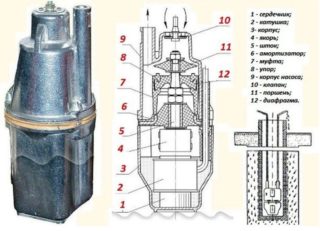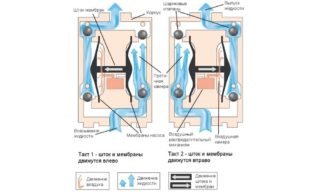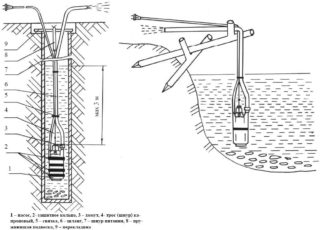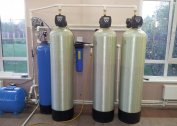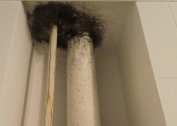Arrangement of a private source (well, spring or well) includes the installation of special equipment for transporting water to the house. More often, craftsmen prefer to use a vibration pump with a lower or higher water intake. This small device has good performance and a bargain price. More often choose the pumps "Kid" or "Trickle."
Device and scope
To understand what this small well / well unit is, you need to master its device. The pump consists of the following parts:
- Power element. This includes the core and coil. In tandem they form a magnet. The core is encased in silica sand and epoxy. The first removes thermal energy, and the resin provides insulation of the winding from water.
- Vibrator. This is a magnet connected to the rod and shock absorber in series.
- Coupling. It is localized immediately after the shock absorber and protects the electrical component of the pump from the negative effects of water.
- An injection chamber for collecting fluid from a well or well. From it, water is then transported upward through a hose.
- Rubber piston. It is fixed on the stem and provides pressure differences in the working chamber (discharge and discharge). The movement of the rubber piston slightly limits the emphasis that is between it and the clutch.
- Inlet valve. Changes its position depending on the pressure in the working chamber. When it falls, the valve opens. With an increase, it closes. At the top of the pump is the same valve (outlet). It works on the opposite principle. With increasing pressure, it opens. When reduced, it closes.
Due to its simple structure, small size and optimal performance, the LEL is used in such cases:
- watering garden gardens to get a good harvest;
- pumping water from flooded rooms;
- fluid supply from a well or well to an autonomous water supply system;
- filling the pool with water;
- washing a car in the yard or washing carpets, etc.
LELs are devoid of rotating elements, which means that the device does not need lubrication. For a submersible vibration pump with an upper water intake or with a lower water intake, water itself acts as a lubricant.
The principle of operation of the NIP
The operation of the vibrating submersible pump is based on the pressure drops in the working chamber. It looks like this:
- The pump connected to the network provokes the winding of the coil to action, that is, it creates an electromagnetic field.
- It, in turn, pulls a vibrator located in the discharge chamber.
- The diaphragm bends, which provokes a pressure drop in the working chamber.
- The inlet valve opens and water enters the tank.
- As soon as the tank is filled, the pressure rises again, the valve closes, and water flows up the pipe.
The frequency of magnetization / demagnetization varies between 100 times per second. As a result of such work, vibrations arise, due to which the pump got its name.
Modifications of Submersible Vibration Pumps
All vibratory pumps are classified into species in several categories. By type of water intake:
- Lower fluid injection. The valve is located below.
- Top water intake. Here, the inlet valve is located on top.
By the number of valves, the LEL are divided into single-valve and two-valve.The second option has great power and performance.
In this case, all the LEL can be made of durable plastic or aluminum.
Vibration submersible pumps are also classified by the manufacturer into domestic and foreign. Of the domestic ones, the most common ones are: “Aquarius” (aka Poseidon), “Kraton”, “Stavr NPV 300”, HMS “Malysh” pump with built-in thermal protection, technological instrument “Trickle”, etc.
Criterias of choice
When choosing an NPS, it is recommended to be guided by the following criteria:
- The immersion depth of the pump. Recommended values for a particular model are compared with a constant average water level in the source.
- Pump performance. It should be slightly less than the debit of the well / well. Productivity is measured in liters over a certain period of time.
- The height of the rise of water and its transportation. This parameter, among others, is indicated in the technical specifications for the unit.
- The diameter of the body of the device. Especially if LEL is acquired for the well. The cross section of the pump flask must be less than the diameter of the casing, otherwise the unit will not enter it.
It is advisable not to operate a vibrating submersible pump for water with a temperature above 35 degrees.
NPS Mounting Steps
To install a pump in a well or a well, it is necessary to perform work in the following sequence:
- Welding a strong metal frame on which the unit will be mounted. The frame is installed on top of the well or casing.
- Stretch the hose / pipe and power cord from the pump parallel to each other on the ground.
- A valve is attached to the inlet of the LEL, and a coupling to it.
- The latter is connected to a pipe for supplying water.
- The power cable is attached to the pipe in parallel with clamps. The wire should not be tight, its slight sagging is acceptable. For cable fastening use clamps. You can use electrical tape, but it is less reliable. Over time, its pieces can get into the water and clog the pump.
- An additional nylon safety rope is fixed to the LEL. It is on it that the unit will hang. It is better not to take a steel cable, since it rusts over time and becomes unusable. As a result, the unit may break.
- Holding the pump by the safety cable, it is lowered to the desired depth and fixed to the frame. An electric cable and a pipe are attached here.
It is forbidden to hold the LEL by the wire while diving.
Advantages and disadvantages of submersible vibration pumps
All NPS have several advantages and disadvantages. The pluses include:
- optimal performance;
- the possibility of pumping dirty water with impurities of sand, soil and other small-fraction waste;
- the exception of overheating when working in cold water;
- reliability due to the lack of complex nodes in the device;
- favorable cost;
- service life up to 10 years.
The minuses include:
- Pump intolerance to idle. If the water level in the source drops and the unit runs for at least 5-25 seconds, it will fail.
- Sensitivity to voltage drops. Even if it changes by 10%, the pump will not work efficiently. With a voltage surge, the details of the LEL wear out many times faster.
- Wear of rubber elements. Especially in water mixed with sand.
- Unscrew all threaded connections. To prevent this from happening, it is better to immediately replace them.
As a rule, wear of rubber parts is not critical. It is enough just to replace them yourself, and the unit will pump water again.
With proper operation and taking into account all the operating parameters of the unit at the time of purchase, the pump does an excellent job of providing water to a small country house with a family of 2-3 people.
